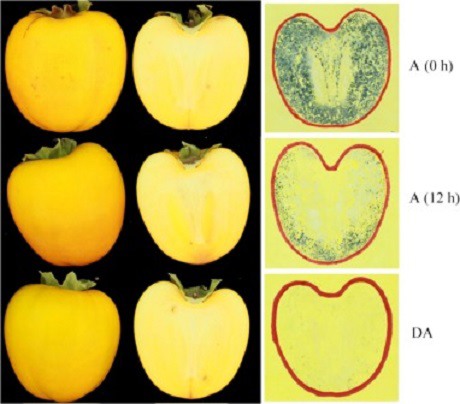The persimmon (Diospyros kaki) fruit cv. Rojo Brillante is an astringent cultivar for its content of soluble tannins, which are insolubilised during the ripening of the fruit. Traditionally, the consumption of the fruit has only been possible when it is overripe and its texture is soft. Postharvest treatments based on exposing fruits to high CO2 concentrations allow astringency removal and high flesh firmness maintenance.
"To date, there are only subjective and destructive analytical methods to monitor the effectiveness of the astringency removal treatments in persimmon," was reported by the scientists at Instituto Valenciano de Investigaciones Agraria, Universitat Politècnica de València and Universitat de València that have evaluated the application of hyperspectral imaging, as a non-destructive method, in the spectral range 450–1040 nm to discriminate astringent (A) and deastringed (DA) persimmons.

The scientists used a threshold of soluble tannins based on sensorial perception (0.04% of fresh weight) for the discrimination of fruit type. The spectral information from three different areas of each fruit (calyx, middle and apex) was used to build models to predict the soluble tannins (ST) content using partial least squares regression (PLS-R). The results using PLS-R method showed that it was not possible to accurately discriminate fruit with levels of ST below 0.04%, especially in the case of DA fruits (42.2%). Thus, another classification models were performed using partial least squares discriminant analysis (PLS-DA) that included other properties apart from ST for a correct classification.
"The most accurate models were those which focused on the middle and apex areas of the fruit, a correct classification rate of 87.0% being achieved for A fruits and above 84.4% for DA fruits. The results indicate that hyperspectral images can therefore be considered as an objective and non-destructive alternative in the control of this process," the scientists conclude.
Source: Sandra Munera, Nuria Aleixos, Cristina Besada, Juan Gómez-Sanchis, Alejandra Salvador, Sergio Cubero, Pau Talens, José Blasco, 'Discrimination of astringent and deastringed hard ‘Rojo Brillante’ persimmon fruit using a sensory threshold by means of hyperspectral imaging', 2019, Journal of Food Engineering, Volume 263, pages 173-180.
